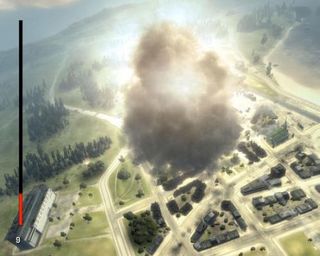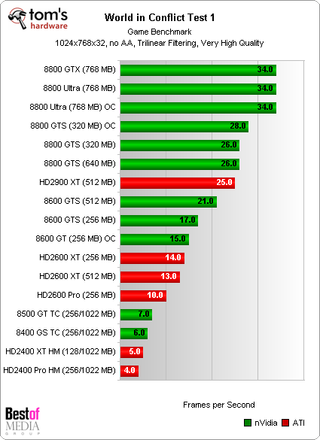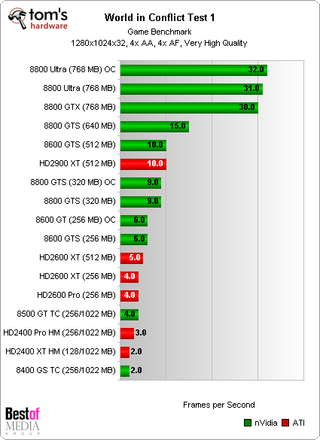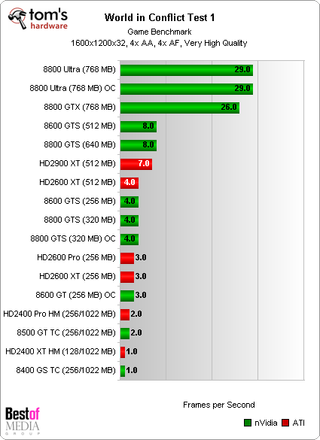DirectX 10 Shootout: Nvidia vs. ATI
Benchmarks - World In Conflict Test 1
World in Conflict has thus far presented itself in three steps, namely beta client, demo, and now the final retail version. The game is a representative of the RTS genre with extreme graphics effects set in an alternate timeline where WWIII broke out in the late 1980s.

While both the beta client and the demo were plagued by compatibility problems, the final version is thankfully a lot more polished. Previously, changing the resolution or graphics quality would often either freeze or crash the game. As a workaround, gamers were usually instructed to install the most recent beta graphics drivers. This is no longer necessary, as the official releases now run the game faultlessly. However, the Radeon HD 2400 XT and 2600 Pro and 2600 XT cards with 256 MB of video memory can still run into an occasional problem. Although the benchmarks run fine, the game crashes sometimes when the graphics quality setting is changed, even though the new settings are accepted. Note: Our 2400 XT and 2600 XT boards are early samples we received directly from ATI. If you continue to experience problems, delete the game directory in your Documents folder. (Don't forget to make a backup of your saved games, though!)
World in Conflict is a very demanding game. With the graphics quality set to High, you'll need at least a Radeon 2600 or a Geforce 8600 with 512 MB of video memory. If your card has less RAM, you're either limited to the Medium setting, or the game will start in DirectX 9 mode the next time it is launched.
We divided this benchmark into two sub-tests. The first one draws on the official benchmark feature integrated in the game, which consists of several sequences and then displays a result. The most extreme effect, a huge explosion, reduces even the fastest cards in this group to a stutter (12 to 18 fps).
Only the Geforce 8800 GTX and Ultra are able to run World in Conflict smoothly. While additional video memory has little impact on ATI cards, having twice the RAM results in double the frame rate on Nvidia's cards at higher resolutions. Enabling anti-aliasing on the 2900 XT cuts its performance in half. The Geforce 8800 GTS suffers from a performance drop starting at 1280 x 1024.





Stay on the Cutting Edge
Join the experts who read Tom's Hardware for the inside track on enthusiast PC tech news — and have for over 25 years. We'll send breaking news and in-depth reviews of CPUs, GPUs, AI, maker hardware and more straight to your inbox.
Current page: Benchmarks - World In Conflict Test 1
Prev Page Benchmarks - Lost Planet Next Page Benchmarks - World In Conflict Test 2-
i have and have been using an old ati x800 gt 256 mb ddr3 i can run bioshock at low res this being an old card i got no hope of a successful upgrade from atiReply
Most Popular


